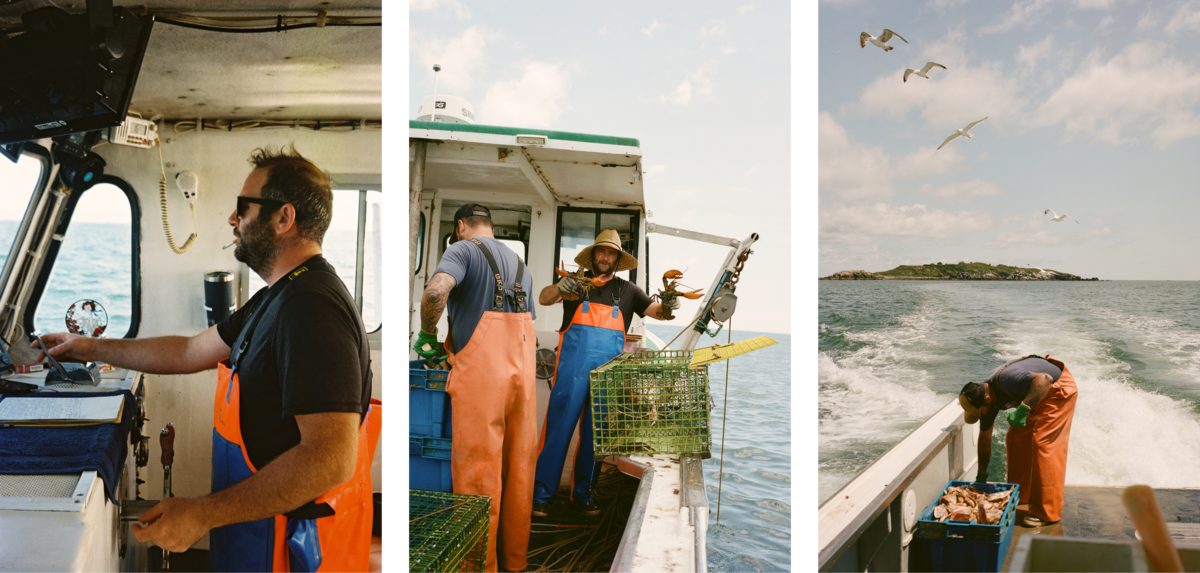Giant Magazine


For years, we produced catalogs that sold the things we made and loved. In them, we told stories of the men and women across America doing good work.
Their stories inspired us and we began to ask why we didn’t do it more. GIANT Magazine is the result of those conversations. It features stories about the days of people working in America. In kitchens in the South, on boats in New England and in the woods of California, these people work together—day in, day out, in common purpose. Because we believe that hard work is a beautiful thing.


Deep in the rugged terrain of California’s Tahoe National Forest, a crew of elite firefighters known as the Tahoe Hotshots are preparing. The sun is just making its way over the treeline, and they are running. Six-minute miles along a narrow dirt trail, pushing themselves to clock a faster time than the day before, honoring a legacy passed to them by those who came before. They know the standard they must keep and recognize the dangers they will face in the coming wildfire season.
Peak physical condition is non-negotiable. Unlike urban firefighters equipped with fire engines and water lines, Hotshot crews (given their moniker because they are sent to the hottest parts of a wildfire) rely only on what they carry. Chainsaws, axes, shovels, fire rakes—these are the tools of their trade, and they care for them meticulously. Cleaning, sharpening, oiling and checking like a marine would his weapon.

Made up of about 20 members at any given time, the Tahoe Hotshots live together as a unit in the middle of the forest for the entire fire season—about six to eight months out of the year—forming unique and unbreakable bonds. They train together, eat together and play together. They are close like siblings; even though there’s some competition in the air, they’d die trying to protect each other.
To be a Hotshot means that you are one of the most skilled and physically fit firefighters in America, battling at the frontlines of wildfires that rake across North America every year. The Caldor Fire in 2021, which destroyed more than 600 homes and ravaged South Lake Tahoe, sticks in many of their minds. When the call comes, they could be sent anywhere in the country, dropped straight into the frontlines of the flames. During these grueling 18-hour days, they push themselves to the brink, physically and mentally.
But the work involves much more than the exhausting, complicated job of building fire breaks, felling trees and digging ditches. Hotshots are often the ones directing the strategy, making split-second decisions that can mean the difference between life and death. Described as “students of fire,” the job demands constant learning and adapting to fires that seem to be getting faster, bigger, and more difficult to control. While Hotshots used to spend 80% of their time in remote areas and 20% in the wildland-urban interface, that ratio has now flipped. As fires inch closer to people, they become more complex given the need to navigate the public, evacuations and infrastructures.
The tradition comes down from those that preceded them. Hard work, peak conditioning and sound decision-making in the most intense of situations means that the members of this elite crew of firefighters need to bring their best every day.




On a summer morning in the harbor off Hull, Massachusetts, fishermen begin arriving in pickup trucks, cups of coffee steaming in the pre-dawn light. They are here for lobster. They board their boats in the dark, clad in rubber boots lugging pails of ripe-smelling bait. Two- or three-man crews setting out for a day of hauling traps. Leaving early because that’s what the old dogs who came before them did, getting on the water before the sun so they can get home and have most of the day with family and friends. It will be more than six hours before most are back to the dock, but out on the ocean, they’re home.
For many in these small coastal towns like Hull, Massachusetts and Stonington, Maine, trapping lobsters is a way of life. Many of the men remember days as young kids jumping in the backs of boats to head out with crews to fish. They dreamt of being able to captain their own boats one day, free to fish the open waters, to spend their days at sea, and make a living their own way. Over time, it gets in your blood. So much that retired lobstermen often show up long after they’ve hung up their boots, hopping on a boat here and there, not because they need to, but because it’s what they know. And, after decades hauling traps, it’s who they are.

Fishing towns like these dot the coastline from Rhode Island to Maine, where thousands of lobstermen ply their trade every day. They are part of a centuries-old tradition passed down through generations. Unlike large commercial operators, these independent, owner-operated boats are small-scale, often run by a family or friends who rope their buddies into going out to sea. They are at once pirates hunting for treasure and small business owners daring to take on unpredictable seas and markets to make a living.
It’s not a hobby, but something earned. Not everyone is cut out to fish. It takes years of training, often working on an established boat under an experienced captain to learn the trade: how to navigate, how to bait and repair traps, how to change the oil on the boat, the rules and regulations, the trial and error of where to drop your traps and when. This apprenticeship links one crew to another, neighbor to neighbor.
On any given day, a crew might set hundreds of traps and haul hundreds more in a grueling quest for legal lobsters to sell to local markets, often in bad weather and rough seas. But the return is freedom, the open ocean, the salty air and the ability to decide how hard to push yourself, who to work with and how to spend your working hours.
Most lobstermen say their best days are when the traps are full. It’s the thrill of the catch that motivates them; the chase to find the best spots, the competition, the shuffling and resetting of traps from rocks to mud to sand; the joy that comes with pulling up full. It’s hard, taxing work. Filled with long days, the smells of rotting bait and diesel, sweat from hauling the traps in and oil from working on their boats. But out on the open water—with the freedom to roam, laughing and searching with the crew—it feels like life itself.




Diners won’t arrive for a few more hours, but Sean Brock’s new restaurant in the heart of East Nashville, Audrey, is already alive. All of the staff—dishwashers, servers, sous chefs—line up to load freshly made sausages onto warm rolls on their plates, smothering them with a feast of toppings.
This family meal is a daily ritual, one that grounds them before the storm of guests. The crew fuels up as the work begins. Chefs debrief the staff on what to expect for the night: the dishes on the menu, the wine that pairs, and the cocktails in season.
The room turns quiet as sous chefs in crisp white shirts and black aprons begin presenting a series of meticulously crafted dishes. These plates won’t go to guests—at least not until next season—but that doesn’t make them any less important. Developed over months, each new recipe that makes it onto the menu at Audrey must go through careful, devout development—and pass the palate of head chef Brock.

As he approaches the counter, he prepares himself to taste. The chefs watch—and wait.
Over the last year, this team has created dozens of dishes together—far outpacing what a typical kitchen might design in a year. But this group has a vision: create dazzlingly fresh and provocative dishes that have never been done before, and do so while honoring the integrity of the flavors and ingredients of the Appalachian South.
It’s a mission Brock has been known for since he opened his first restaurant, Husk, in 2010 and soon after won the James Beard award for best chef of the Southeast. Audrey, opened in 2021, is his most personal venture yet—named after his grandmother, his biggest inspiration. The real Audrey worked as a butcher, kept bees, gardened and was always cooking and caring for people. He wanted to honor her and create a place that pushed the limits of food, but in a joyful environment that makes everyone better. This restaurant is family to him; and you take care of family.
It’s the intensity of the creative process and the shared reverence for tradition that bonds the team here. The chefs and cooks don’t just chop, dice, sauté. They create dishes with the knowledge that each ingredient is the result of the care and sweat of local farmers, born out of years of harvests and the traditions of families who have worked the land for generations.
At any given time, there are only 12-25 ingredients to choose from—the freshest, seasonal from the region. Sweet potatoes, Ossabaw pork, dried Appalachian berries. Each is essential. A recipe is not just a grocery list to put in a pot, but rather a series of stories behind the ingredients themselves.
The kitchen is an inspired place, filled with the energy of honoring and celebrating these ingredients and these people. Anchoring the ingenuity, technique and creativity in deep tradition gives the kitchen a sense of purpose. A mission. The tension between the new and the old, invention and tradition creates a beautiful place filled with the sense of purpose and family.
In this kitchen, the inspiration makes the tiring, intense work exciting. These innovative dishes emerging from the traditions of the South are something entirely unique. They’re produced by a passionate group that cares for their suppliers, and, in turn, each other. One feeds the other. The staff knows they’re part of something at once elite and nostalgic. The pursuit fuels them as much as it fuels Brock. Standing in the kitchen feels like you are a part of something much larger, doing some small part to shine a light on the importance of traditions and craft that, if not celebrated and loved, could drift into the distance. This team, tasting dishes emerging out of their bustling kitchen, seems duty-bound to introduce a new generation of Americans to the wonders of the past.













SEE OUR PRODUCTS IN A NEW LIGHT


